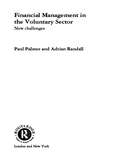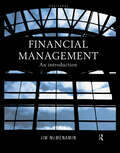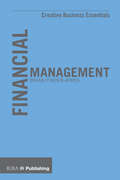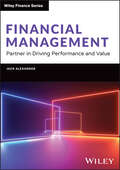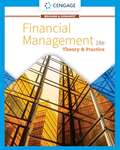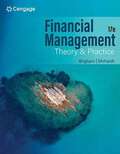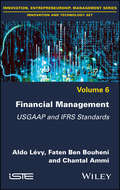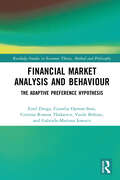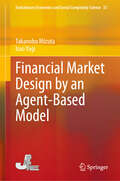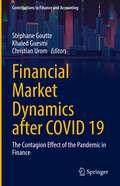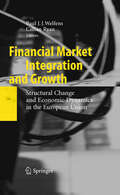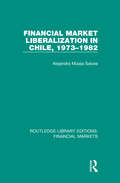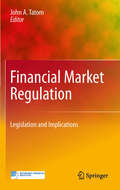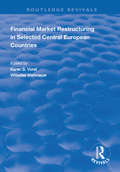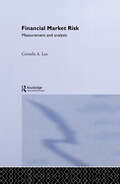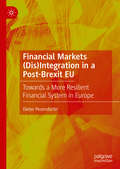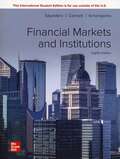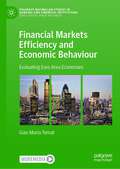- Table View
- List View
Financial Management in the Sport Industry
by Matthew T. Brown Daniel A. Rascher Mark S. Nagel Chad D. McevoyThis book provides readers with an understanding of sport finance and the importance of sound financial management in the sport industry. It begins by covering finance basics and the tools and techniques of financial quantification, using relevant sport examples. It then goes beyond the basics to show how financial management works in the industry--how decisions are made to ensure wealth maximization. Discussions include time value of money, capital budgeting, facility financing, economic impact, and risk and return. The final part of the book focuses on three sport industry sectors--parks and recreation, collegiate athletics, and professional sport--providing in-depth analysis of financial management within each sector. Throughout, sidebars, case studies, concept checks, and financial problems enable thorough study and practice. Readers learn to apply, and see how sport managers apply, sport financial management principles in real-life situations. Altogether, it offers a good balance of first presenting background information on financial management and then spending the majority of its pages focusing on these concepts in a sport-specific context.
Financial Management in the Voluntary Sector: New Challenges (Routledge Studies In The Management Of Voluntary And Non-profit Organizations Ser.)
by Adrian Randall Paul PalmerThe voluntary sector contains over 50,000 organizations, 320,000 paid staff, and 3 million volunteers. The accounting and financial management of organizations in this sector poses as many difficulties as that of major for-profit organizations, if not more so, given the absence of the profit motive upon which much traditional accounting, finance pr
Financial Management of Family Businesses: Transparency – Compliance - Performance – Strategy - Governance (Contributions to Finance and Accounting)
by Thomas Zellweger Patricio OhleFinancial management in family businesses is a special challenge. CFOs in particular are often at the crossroads of various interests and roles. However, not least the public reticence of family businesses has so far ensured that there is a lack of knowledge about these interrelationships. A specialist circle of CFOs from large German-speaking family businesses is dedicated at the Center for Family Business at the University of St.Gallen (Switzerland) to discuss these issues . In this book, these experts share their wealth of knowledge and experience with the public for the first time. Along a five-step model, they shed light on key areas of responsibility that go far beyond mere financial management. They discuss issues of transparency and compliance, from performance and strategy to governance - and provide concrete suggestions for everyday business life. Whether manager, owner, or advisory board member, anyone who bears responsibility in a family business can benefit from this bridge between theory and practice.The CFO network fbxperts.ch has also been present internationally since 3 years: in Italy, Spain, France, UK and other locations.
Financial Management: An Introduction
by Jim McMenaminFinance is a notoriously difficult core subject for business undergraduates, which many find difficult to understand. The area has been dominated by large and complex introductory texts - often from the US - which many lecturers find too detailed and unwieldy.This carefully developed and researched text will fill this gap by providing a succinct, modular, UK-focused introduction to the subject of financial management. Quality controlled by an academic review panel, the content and approach has been rigorously developed to answer the needs of non-finance students.The user-friendly features and design will be of great appeal to the many undergraduates who find finance a difficult subject. Examples, models, formulas, and exercises are lucidly and clearly presented, supported by strong pedagogical features - learning objectives, worked examples, key learning points, further reading, practical assignments, references, case studies and teacher's guide.This ensures that Financial Management will prove the most accessible text for business and finance students.
Financial Management: Bullet Guides
by Philip RamsdenOpen this book and you will Master basic finance Manage balance sheets Budget effectively Foster success
Financial Management: Good Practice Guide
by Brian Pinder-AyresMost newly qualified architects have scant knowledge about the practicalities of running a practice and in particular the challenges of managing the financial side of the business. This book highlights the major financial risks and how these can be avoided.The chapters give straightforward advice and practical solutions based on the author's years of hard-won experience. Friendly, clear and concise, it will give you all the knowledge and tools you need to plan for business success.Based on the original Good Practice Guide, this updated and re-designed version is now even more comprehensive and contains detailed information on fees, as well as real life anecdotal advice from practitioners, updated references, and is in line with the latest legislation. This is invaluable reading for sole and small practitioners of architecture and other creative industries.
Financial Management: Partner in Driving Performance and Value (Wiley Finance)
by Jack AlexanderA comprehensive and insightful approach enabling finance mangers to contribute to business performance and valuation In Financial Management: Partner in Driving Performance and Value, experienced financial executive and consultant Jack Alexander delivers a fresh, new take on improving performance and creating shareholder value for CFOs, controllers, C-suite executives, and FP&A professionals. In the book, you’ll learn about best practices in operational and strategic planning, forecasting, enterprise performance management, business valuation, capital investment, mergers and acquisitions, developing finance talent, supporting growth, and more. Frameworks for dealing with the pace of change and level of uncertainty in today’s environment are also provided, including scenario planning, business agility and monitoring external forces. The book provides actionable insights and practical tools for finance professionals to contribute as trusted advisors and business partners. The author offers free access to financial models in Microsoft Excel and PowerPoint templates on the accompanying website, as well as: Expanded and enhanced content from the author’s widely read previous works Models, illustrations, examples, and dashboards Anecdotes and stories drawn from the author’s 45-year-long career in financial leadershipPerfect for CFOs, controllers, financial executives, financial planning and analysis professionals, and accounting managers, Financial Management is also the ideal desk reference for treasurers, strategic planners, Certified Public Accountants, and equity research analysts. It’s an essential and timely resource for financial leaders everywhere.
Financial Management: Principles and Applications
by John D. Martin Sheridan Titman Arthur KeownIt can often be challenging to see how financial concepts relate to your daily routine and prospective career. Financial Management gives you a big picture perspective of finance and how it’s important in your personal and professional lives. Using 5 key principles, the text weaves in real-world issues to demonstrate the practical applications of critical financial concepts. The 14th Edition has been updated with brand new Personal Applications of Corporate Finance features, study problems, and the latest data and current events.
Financial Management: Theory And Practice (Mindtap Course List)
by Eugene F. Brigham Michael C. EhrhardtAn understanding of finance theory is absolutely essential if students are to develop and implement effective financial strategies. Similarly, students simply must have a working knowledge of the financial environment. FINANCIAL MANAGEMENT: THEORY AND PRACTICE remains the only text in the market that presents a balance of financial theory and applications. <P><P>Authors Brigham and Ehrhardt maintain the same four goals that have made their text a course favorite through each edition: helping learners to make good financial decisions, providing a solid text for the introductory MBA course, motivating learners by demonstrating finance is relevant and interesting, and presenting the material clearly. Plus, with access to CengageNOW for Finance as well as Thomson ONE-Business School Edition, FINANCIAL MANAGEMENT: THEORY AND PRACTICE offers the most comprehensive teaching and learning solution you will find.
Financial Management: Theory and Practice
by Eugene F. Brigham Michael C. EhrhardtGain the understanding of finance you need to make good decisions on the job and advance in your career, whether you work in finance or any other business discipline. Brigham/Ehrhardt’s FINANCIAL MANAGEMENT: THEORY AND PRACTICE, 17E emphasizes key theoretical concepts, equipping you with practical tools for effective decision making. This updated edition focuses on corporate valuation and its importance in financial decisions as you examine the big picture as well as financial details. Chapters connect concepts and tools with fully integrated Excel models that you can apply to typical employment situations. Topics advance from fundamentals to strategic finance, linking recent events to finance in business or your personal life. MindTap online learning platform is also available to reinforce learning. With a relevant presentation, numerous examples and emphasis on Excel applications, this edition provides a comprehensive resource for use throughout your academic and business career.
Financial Management: USGAAP and IFRS Standards
by Chantal Ammi Faten Ben Bouheni Aldo LevyThis book combines the fundamentals of finance with relevance and effectiveness. It allows for the practice of this subject and covers all the programs of business schools, universities' finance courses, and engineering schools. This book is a relevant tool to acquire all the knowledge required for examination success and the achievement of proven practical competences.
Financial Market Analysis and Behaviour: The Adaptive Preference Hypothesis (Routledge Studies in Economic Theory, Method and Philosophy)
by Emil Dinga Camelia Oprean-Stan Cristina-Roxana Tănăsescu Vasile Brătian Gabriela-Mariana IonescuThis book addresses the functioning of financial markets, in particular the financial market model, and modelling. More specifically, the book provides a model of adaptive preference in the financial market, rather than the model of the adaptive financial market, which is mostly based on Popper's objective propensity for the singular, i.e., unrepeatable, event. As a result, the concept of preference, following Simon's theory of satisficing, is developed in a logical way with the goal of supplying a foundation for a robust theory of adaptive preference in financial market behavior. The book offers new insights into financial market logic, and psychology: 1) advocating for the priority of behavior over information - in opposition to traditional financial market theories; 2) constructing the processes of (co)evolution adaptive preference-financial market using the concept of fetal reaction norms - between financial market and adaptive preference; 3) presenting a new typology of information in the financial market, aimed at proving point (1) above, as well as edifying an explicative mechanism of the evolutionary nature and behavior of the (real) financial market; 4) presenting sufficient, and necessary, principles or assumptions for developing a theory of adaptive preference in the financial market; and 5) proposing a new interpretation of the pair genotype-phenotype in the financial market model. The book's distinguishing feature is its research method, which is mainly logically rather than historically or empirically based. As a result, the book is targeted at generating debate about the best and most scientifically beneficial method of approaching, analyzing, and modelling financial markets.
Financial Market Bubbles and Crashes
by Harold L. VogelDespite the thousands of articles and the millions of times that the word 'bubble' has been used in the business press, there still does not appear to be a cohesive theory or persuasive empirical approach with which to study 'bubble' and 'crash' conditions. This book presents a plausible and accessible descriptive theory and empirical approach to the analysis of such financial market conditions. It advances such a framework through application of standard econometric methods to its central idea, which is that financial bubbles reflect urgent short side rationed demand. From this basic idea, an elasticity of variance concept is developed. It is further shown that a behavioral risk premium can probably be measured and related to the standard equity risk premium models in a way that is consistent with conventional theory.
Financial Market Bubbles and Crashes, Second Edition: Features, Causes, and Effects
by Harold L. VogelEconomists broadly define financial asset price bubbles as episodes in which prices rise with notable rapidity and depart from historically established asset valuation multiples and relationships. Financial economists have for decades attempted to study and interpret bubbles through the prisms of rational expectations, efficient markets, and equilibrium, arbitrage, and capital asset pricing models, but they have not made much if any progress toward a consistent and reliable theory that explains how and why bubbles (and crashes) evolve and can also be defined, measured, and compared. This book develops a new and different approach that is based on the central notion that bubbles and crashes reflect urgent short-side rationing, which means that, as such extreme conditions unfold, considerations of quantities owned or not owned begin to displace considerations of price.
Financial Market Bubbles and Crashes: Features, Causes, and Effects
by Harold L. VogelEconomists broadly define financial asset price bubbles as episodes in which prices rise with notable rapidity and depart from historically established asset valuation multiples and relationships. Financial economists have for decades attempted to study and interpret bubbles through the prisms of rational expectations, efficient markets, equilibrium, arbitrage, and capital asset pricing models, but they have not made much if any progress toward a consistent and reliable theory that explains how and why bubbles (and crashes) evolve and are defined, measured, and compared. This book develops a new and different approach that is based on the central notion that bubbles and crashes reflect urgent short-side rationing, which means that, as such extreme conditions unfold, considerations of quantities owned or not owned begin to displace considerations of price.
Financial Market Design by an Agent-Based Model (Evolutionary Economics and Social Complexity Science #33)
by Takanobu Mizuta Isao YagiThis is the first book to focus on designing a financial market that works well, and that includes making and/or modulating detailed regulations and/or rules, by a computer simulation of an agent-based artificial financial market model (ABAFMM). The design of a financial market is very important for the development and maintenance of an advanced economy, but designing it is not easy because changes in detailed rules, even those that seem trivial, sometimes have unexpectedly large impacts and side effects in a financial market, which is a complex system. Traditional economics cannot treat a financial market as a complex system in which micro–macro interaction and feedback loops have played essential roles, because traditional economics can only treat macrophenomena and micro processes separately. ABAFMM can do it, however. This book explains, first, why ABAFMMs are needed to design financial markets and which models have good features. Following that explanation, the book discusses how to build the models. Then, cases of recent studies and their contributions are shown, and finally, the difficulties of researchers in this field are considered. This book is expected to facilitate the design of more ABAFMMs to contribute to creating financial markets that will further develop and maintain advanced economies.
Financial Market Dynamics after COVID 19: The Contagion Effect of the Pandemic in Finance (Contributions to Finance and Accounting)
by Stéphane Goutte Khaled Guesmi Christian UromThis book analyses the impact of the COVID-19 pandemic in different areas of Finance emphasizing the contagion effect in capital markets. The volume presents evidence-based case studies from the global financial crisis that followed after the onset of the pandemic in March 2020.
Financial Market Integration and Growth
by Paul J.J. Welfens Cillian RyanFinancial capital, whether mediated through the financial market or Foreign Direct Investment has been a key factor in European economic growth. This book examines the interaction between European and global financial integration and analyses the dynamics of the monetary sector and the real economy in Europe. The key analytical focus is on the theoretical and empirical dynamics of financial markets in Europe, however, it also provides regional case studies of key institutional developments and lessons from foreign direct investment. There is a broad range of findings for Central, Eastern and Western Europe as well as EU Partner Countries. Crucially the analysis includes new approaches and options for solving the transatlantic banking crisis and suggests policy innovations for a world with unstable financial markets.
Financial Market Liberalization in Chile, 1973-1982 (Routledge Library Editions: Financial Markets #10)
by Alejandra Mizala SalcesOriginally published in 1991, Financial Market Liberalization in Chile, 1973-1982, analyses the liberalization of the financial market which took place during the 1973-1982 monetarist experiment. The book addresses the effect this had on the Chilean economy and how this affected effects of the behaviour of the firms which went bankrupt during this period. The book also presents a description of the policies implemented in the Chilean economy during this period and examines the impact that this had on the performance of the financial sector.
Financial Market Regulation
by John A. TatomWhat role should regulation play in financial markets? What have been the ramifications of financial regulation? To answer these and other questions regarding the efficacy of legislation on financial markets, this book examines the impact of the Gramm Leach Bliley Act (GLBA), also called the Financial Modernization Act of 1999, which fundamentally changed the financial landscape in the United States. The GLBA allows the formation of financial holding companies that can offer an integrated set of commercial banking, securities and insurance products. The tenth anniversary of the most sweeping financial legislation reform in the industry's structure is a natural benchmark for assessing the effects of the law and for questioning whether changes are necessary in the working of this historic legislation. The importance of this review is reinforced by a variety of proposals in the last several years to reform the regulation of financial institutions that have attracted considerable attention among regulators and in the financial firms that they regulate. Most recently, the financial crisis and the failure of some large financial institutions have called into question the legitimacy of America's current financial structure and its regulation, including to some degree the GLBA. There is no doubt that regulatory reform is front and center on today's policy agenda. The lessons of the GLBA experience and its effects, both domestic and international, on financial markets and competitiveness, risk-taking and risk management by financial services firms and their regulators will be critical to the direction the country takes and the effort to ensure that future financial crises do not occur or have less costly damage. With contributions from academics, policy experts, and a sponsor of the GLBA, Congressman James Leach, this book is invaluable to anyone interested in financial system reform.
Financial Market Restructuring in Selected Central European Countries (Routledge Revivals)
by Karen S. Vorst Willadee WehmeyerPublished in 1998, this book provides detailed information on the financial markets in selected Central European transitioning economies. The independent countries selected for study in the text are Poland, Hungary, the Czech Republic and the Slovak Republic. The former East Germany is also include due to its proximity to the above countries and its unique experience in the transition process. Each country's section of the book contains articles written by professionals in the selected country. These individuals are economists, central bankers and/or analysts who have first-hand knowledge of the financial system. Each section details: the development in the banking sector plus the role of the central bank and the government in guiding the economy toward the market system; discuses the emerging capital markets and the ongoing process of privatization; and provides an update of the economic progress toward a market system that has been achieved since 1989.
Financial Market Risk: Measurement and Analysis
by Cornelis LosThis new book uses advanced signal processing technology to measure and analyze risk phenomena of the financial markets. It explains how to scientifically measure, analyze and manage non-stationarity and long-term time dependence (long memory) of financial market returns. It studies, in particular, financial crises in persistent financial markets,
Financial Markets (Dis)Integration in a Post-Brexit EU: Towards a More Resilient Financial System in Europe
by Dieter PesendorferThe European Union is creating a Financial Union with a European Banking Union and a Capital Markets Union in reaction to lessons learned from incomplete financial markets integration, the Global Financial Crisis and European Sovereign Debt Crisis. This book critically analyses these projects for a more integrated, resilient and sustainable financial system at a time when the United Kingdom as the member state with the most developed capital markets and the leading global and European financial center, the City of London, is leaving the Union. Neoliberal financial globalization and markets integration policies have led to finance-led capitalism that caused the crises. By building on pre-crises integration ideas, the Union revives and expands the reach of capital markets-based financing and shadow banking. The book discusses the consequences of deeper integration and the future of European financial centers advocating an alternative financial markets integration based on theories explaining finacialization and finance-led capitalism.
Financial Markets And Institutions
by Anthony Saunders Marcia Millon CornettFinancial Markets and Institutions is aimed at the first course in financial markets and institutions at both the undergraduate and MBA levels. While topics covered in this book are found in more advanced textbooks on financial markets and institutions, the explanations and illustrations are aimed at those with little or no practical or academic experience beyond the introductory-level finance courses. In most chapters, the main relationships are presented by figures, graphs, and simple examples. The more complicated details and technical problems related to in-chapter discussion are provided in appendixes to the chapters. Since the author team's focus is on return and risk and the sources of that return and risk in domestic and foreign financial markets and institutions, this text relates ways in which a modern financial manager, saver, and investor can expand return with a managed level of risk to achieve the best, or most favorable, return–risk outcome.
Financial Markets Efficiency and Economic Behaviour: Evaluating Euro Area Economies (Palgrave Macmillan Studies in Banking and Financial Institutions)
by Gian Maria TomatThis book reviews the efficient markets hypothesis from a behavioural finance perspective looking at the stock markets of the five largest Euro economies. It covers some key areas in finance, including efficient markets, equity premium, dividend ratio model, yield curve and term structure, all of which are concepts used to analyse pricing and other behaviour in financial markets. The book studies the term structure of interest rates describing formalizations for zero-coupon and coupon bonds and evaluates results regarding static spot rate and dynamic forward rate regressions for the Euro area. Additionally, it examines the equity premium exploiting variation in stock market returns in both time series and cross-section dimensions, and will be of interest to academics, researchers, and students of financial economics, financial markets, and behavioural finance.

